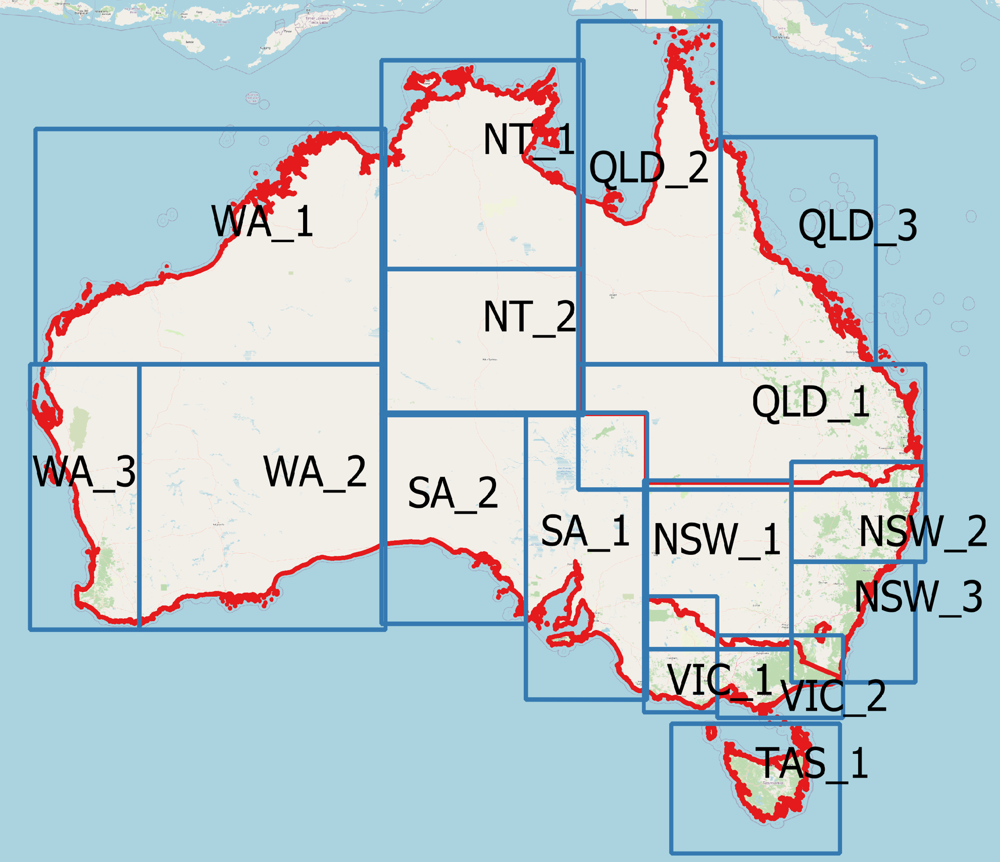IN DEVELOPMENT, FOR ACCESS INFORMATION: ian.macadam@csiro.au
Application-ready climate projections are available for selected climate variables at a daily temporal resolution, for three future time periods in the 21st Century - 2016-2045, 2036-2065 and 2056-2085, for three future greenhouse gas emission scenarios (low-emissions - RCP2.6, mid-range emissions - RCP4.5, and high-emissions - RCP8.5). The following climate variables are included:
- daily maximum surface temperature,
- daily minimum surface temperature,
- daily precipitation,
- daily solar radiation, and
- daily relative humidity.
Consistent historical data are also available for the 1981-2010 period to provide a baseline for analyses of changes into the future.
Data are provided on a 5km grid covering all of Australia. The same data are available for sub-regions of Australia for users with an interest in a specific region.
In addition to the daily data, monthly, seasonal and annual averages are also provided covering all of Australia.
The data have been created by applying future climate changes simulated by a selection of CMIP5 Global Climate Models (MIROC5, ACCESS1-0, CESM1-CAM5, CNRM-CM5, CanESM2, GFDL-ESM2M, HadGEM2 and NORESM1-M) to Australian Bureau of Meteorology AGCD observations and ERA5 reanalysis data using the quantile-quantile scaling, or "QQ-scaling" method. This method results in future climate data that are minimally affected by climate model biases and are more detailed in terms of spatial resolution than the raw climate model output.
The QQ-scaled data provide initial guidance on possible future climate conditions across Australia and, in conjunction with other information about climate change, can be used to inform assessments of the impacts of future climate changes. The climate variables provided are relevant to many climate impacts. Examples include (but are not limited to):
- Daily maximum and minimum temperature data are relevant to agricultural productivity, health, energy usage, the performance of infrastructure and biodiversity.
- Precipitation data are relevant to bushfire risk, agricultural productivity, water resources and biodiversity.
- Solar radiation data are relevant agricultural productivity, renewable energy and the performance of infrastructure.
- Relative humidity data are relevant to bushfire risk, health and water resources.
Prior to purchasing data, potential users are encouraged to download the free sample provided (which covers a limited area of South Australia) to check that the data will meet their needs.

The current CMIP5-based product will be superseded by a product based on more recent, CMIP6, climate modelling. The currently available CMIP5-based product allows users to gain familiarity with the data formats and use cases of the coming CMIP6-based product. The CMIP5-based product is intended solely as a preview of the upcoming CMIP6-based product, and it is unsupported in the sense that future access is not guaranteed and any errors in the data or documentation will not be corrected.
Citation
The dataset should be cited as:
CSIRO Climate Innovation Hub; Dey, Raktima; Webb, Leanne; Macadam, Ian; Irving, Damien; Bodman, Roger; Erwin, Tim; Kitsios, Vassili; Heady, Craig; Thatcher, Marcus; Hennessy, Kevin; Clarke, John; Rodriguez, Michelle; Hemer, Mark; King, Malcolm (2024): Climate Innovation Hub Product 1 - Application-Ready quantile-scaled CMIP5 climate model projections for Australia. v1. CSIRO. Data Collection. https://doi.org/10.25919/n1es-5x31
Further information and feedback
Detailed information about how the dataset was generated using the QQ-scaling method and the strengths and limitations of the data is available in a report:
Webb, Leanne; Macadam, Ian; Nguyen, Kim; Irving, Damien; Bodman, Roger. Climate Innovation Hub Technical Note 1. Quantile-quantile scaled projections. Melbourne, Australia: CSIRO; 2024. csiro:EP2024-0338. https://doi.org/10.25919/88wm-mw53
You are encouraged to contact us at climate@csiro.au if you require assistance with the data, including its interpretation. Feedback on the data, including on its utility, documentation and conditions of use is welcome.
